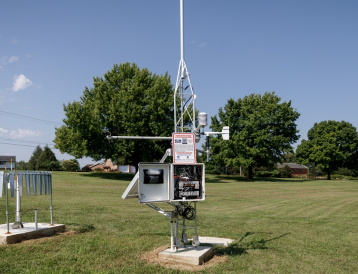Weather watching: Statewide monitoring alert system updated
 Courtesy of PEMA
Courtesy of PEMA
To better prepare for severe weather events, agencies across the state have joined to enhance the Pennsylvania Integrated Flood Warning and Observation System, known as IFLOWS 2.
“This version is very good at providing timely alerts, which is most important in getting out early warnings for potential severe weather,” said Scott Stuccio, state meteorologist with the Pennsylvania Emergency Management Agency (PEMA). “The upgrades are geared toward providing that early-warning capability.”
The IFLOWS 2 system provides accurate real-time information and alerting tools to emergency managers, meteorologists and the public through the Keystone Mesonet. The mesonet – short for mesoscale network – takes information captured at individual weather stations located throughout the state to report basic weather data. Mesonets are invaluable for forecasters to predict adverse weather events, such as wintertime precipitation that could stick to road or bridge surfaces, or approaching thunderstorms that could bring heavy rainfall.
“The Keystone Mesonet is the entire network of not only the IFLOWS 2.0 portion, but also the other parts of our collaborative network with other state agencies,” Stuccio said. “That’s the house for all of those collective weather stations across the commonwealth.”
The networks include stations at Penn State Fayette, the Eberly Campus; Bentworth High School; the Washington County Welcome Center on Interstate 70; the Meadow Lands exit of Interstate 79, and the Greene County Welcome Center along I-79. At each of the sites is a receiver that transmits weather data through cell towers to the National Weather Service and other participating entities. That data can trigger alerts to emergency management professionals.
The latest network upgrade will better supply the NWS and emergency managers with information needed to keep the public safe from severe weather and flooding through early alerting.
“Flooding is the top natural hazard in the commonwealth, and enhancing detection and providing early warning are critical tools to prevent loss of life,” said Randy Padfield, PEMA director. “The enhancement of the IFLOWS will provide emergency managers and forecasters advanced notification for conditions that may lead to flooding or other natural hazards, giving the public extra time to take action.”
This summer brought several rounds of flash flooding in the region.
“With climate change, there is definitely more flooding happening,” Stuccio said. “Rainfall intensity has been a big topic of conversation and study for the last handful of years. In (Washington County and surrounding areas), it started very early this year. The instances of flooding, in particular flash flooding, have been increasing. There’s an obvious need for as good an early warning as possible, and that’s what this network provides.”
The IFLOWS upgrade is funded through a $720,000 grant from the Federal Emergency Management Agency Hazard Mitigation Grant Program. That grant, awarded in December 2022, allows communities to implement sustainable, cost-effective measures to reduce the effect of future natural hazards.
The updated project involves the installation of 30 new weather stations – including one in Bentleyville – across the state through August 2026. The weather stations will tie into Penn State’s recently installed weather network of 20 stations, one of which is located in Mt. Braddock (Fayette County). The 50 weather sensors, which are located across 38 counties, make up the Pennsylvania Environmental Monitoring Network (PEMN).
“These (sensors) are not in the flood plain,” Stuccio said. “That is where a lot of impacts are felt, sometimes more severely than for those who are along a river, a creek or a stream.
“It’s important to get the public prepared,” Stuccio said. “They are our primary stakeholders. We are protecting them. We can’t prevent severe weather from happening, but we can mitigate the effects. That’s what this is all about.”

